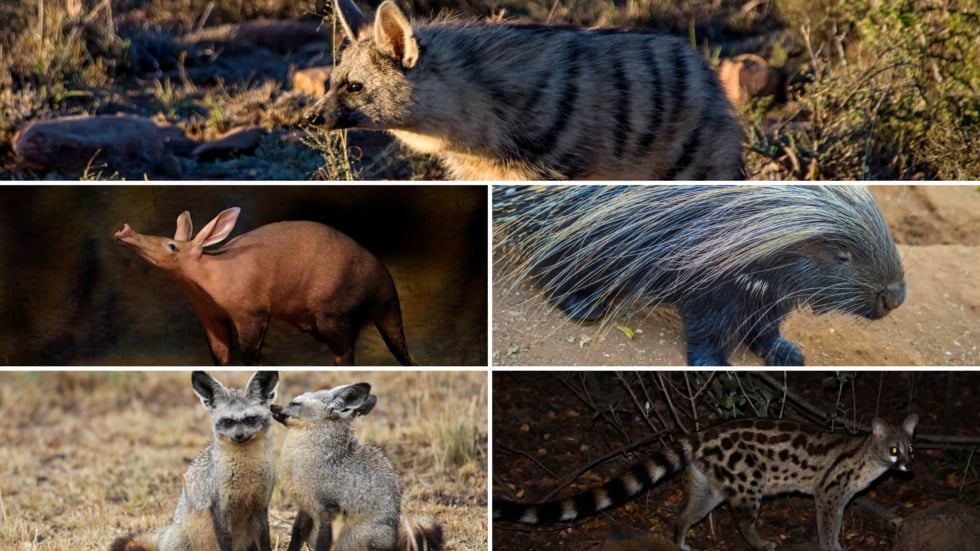
The Karoo is a semi-arid desert region located in South Africa, and well-known for its unique variety of fauna and flora. Despite the harsh environment, this ancient desert is home to a rich diversity of wildlife that has adapted to survive in a truly challenging landscape.
If you are lucky, you will catch glimpses of the following: the Aardwolf, Cape and Bat-eared foxes, African wildcat, Black-footed cat, Aardvark, Porcupine, Striped polecat, African striped weasel, and both Small and Large spotted Genets.
But let’s look a little more closely at a few of these special animals
Aardvark:
Found throughout sub-Saharan Africa, the aardvark is known for its long snout and strong digging abilities. It feeds on ants and termites and is rarely seen during the day. A strange-looking creature with a humped body, a long snout, and a thick tail, aardvarks are greyish brown in colour and can attain a total length of just over seven feet.
Expert diggers, they spend the day sheltering from the sun in deep burrows. When night falls, they emerge to look for termites, which they detect using both smell and hearing. Aardvarks use their powerful claws to dig into termite mounds, before lapping up the insects with their long, sticky tongues. Their rough skin prevents them from being bitten, and it is thought that an adult aardvark can consume as many as 50,000 termites in a single night.
Aardwolf:
This is another nocturnal mammal that feeds on insects, particularly termites. It is a member of the hyena family, but is much smaller and has distinctive stripes on its coat. The name means “earth wolf”, and this elusive animal is certainly wolf-like in appearance. It sports a thick mane that can be raised to make the aardwolf seem bigger to its opponents when threatened. They favour dry, open grassland and savannahs where termite nests are plentiful.
Bat-eared Fox:
This small, nocturnal fox has large ears that help it detect prey in the dark. They feed predominantly on termites, other insects, and small reptiles, and are often seen hunting in pairs or small groups. They get their name from their disproportionately large ears, which help to distribute heat around the body, supporting survival in the extreme heat of the arid savannas in which they live.
The Southern bat-eared foxes are only nocturnal in summer when they seek respite from the heat in underground burrows. In winter, they forage during daylight hours and are easier to spot as a result.
The Small-spotted Genet:
This is the most frequently seen member of a family that may include up to 17 different species. Although their slender bodies and pointed faces are distinctly cat-like in appearance, genets are not classified as felines, they are viverrids – a classification they share with civets.
Small-spotted genets are pale grey in colour, with a black stripe down their spine and several rows of small black spots. Their tails are striped with rings of black and white. Genets are most active just after sunset and just before sunrise and are adept hunters. They prey on small mammals, reptiles, and birds, and are skilled climbers.
Cape Porcupines:
Found throughout Central and Southern Africa, and measuring up to 3.25 feet in length from snout to tail-tip, Cape Porcupines are the largest porcupine species in the world – and the largest rodent species in Southern Africa. Their stocky bodies are covered with black and white banded spines, the shortest of which is also the sharpest. As well as making the porcupine difficult for would-be predators to attack without sustaining serious injury, the tail spines are hollow. When threatened, the porcupine rattles these spines in a warning.
Herbivorous by nature, the Cape Porcupine emerges at night to feed on fruit, roots, and bark. Cape porcupines mate for life and dig a series of burrows across a shared territory that may measure up to 0.8 square miles.
Heuningland: African & Karoo tours to stir the heart and lift the soul
We are proudly South African and have a fervent love of the Great Karoo, its people and its unique vegetation and animals. We are passionate conservationists of nature and would like to share our knowledge acquired through years of travel and touring experience. We are therefore able to offer custom-designed and distinctively different tour options:
- Hiking/camping trails or guided self-driving tours through the ancient landscape of the Karoo.
- Tailor-made safaris to any destination in South Africa, Namibia, Zimbabwe, Zambia, Mozambique, and Botswana.
Find out more at: www.heuningland.com




